There is something deeply propagandistic in the disappearance of the notion of propaganda from artistic discourse. The word only resurfaces bluntly to dismiss certain practices as one-dimensional, as pamphletism, or as ideological and doctrinal. In our capitalist-democratic age, art is merely expected to “hold up mirrors,” to “ask questions,” and to show the ambiguities of our existence. As Hito Steyerl succinctly stated: “If contemporary art is the answer, the question is: How can capitalism be made more beautiful?”1 Art’s answer comes precisely in the form of a permanent critical questioning insulated from affecting the foundation of violent exploitation that sustains the capitalist-democratic doctrine.
The disappearance of the notion of propaganda is the result of a delicate ideological operation meant to obscure the fact that modern propaganda was developed by capitalist-democratic countries, rather than by so-called totalitarian ones. Our unwillingness to speak of art as propaganda proves the success of this operation. The Venice Biennale and its relation to the phenomenon of the world fair is a case study that could help us both understand the inherent propagandistic role of art in capitalist democracy, and reactivate our political relation to the practice of art in the realm of global politics.
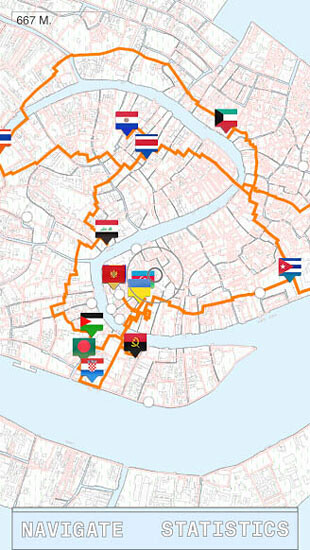

The organization of the Venice Biennale’s pavilions should be interpreted as a 118-year-old cultural allegory of the rise of the nation-state. The first edition of the Venice Biennale took place in 1895, making it the oldest biennial in the world. The 2013 edition consisted of seventy-eight national exhibitions, each attributed to a specific country. These pavilions function as embassies, where each country showcases the art it believes best represents current developments in its art sector. In Venice, art narrates the formation of what I will refer to as the democratist nation-state—one of the most dominant political constructs of our time. The artworks displayed in the increasing number of national pavilions aim to enforce the myth of a benevolent and culturally appreciative civilized state, thus legitimizing the “democratic” bona fides of autocratic, colonial, and fascist regimes:
The first countries to decide “to put itself on display” at the Biennale were large and powerful colonial powers such as Belgium, the first to erect a pavilion in 1907. During the twenty-year reign of Fascism there was an explosion of requests, and subsequent concessions for the pavilions. By 1942, a total number of 19 pavilions existed. Today inside the Giardini of the Biennale, there are 30 national pavilions representing 34 countries, the last having been built by South Korea in 1995.2
However, to call the artworks exhibited at the Venice Biennale “propaganda” would be missing the point. Instead, there should be a distinction made between the artworks on display and the infrastructure within which they circulate. This infrastructural dimension of the representation of contemporary art will allow us to grasp the art world’s role in establishing the global doctrine of capitalist democracy.
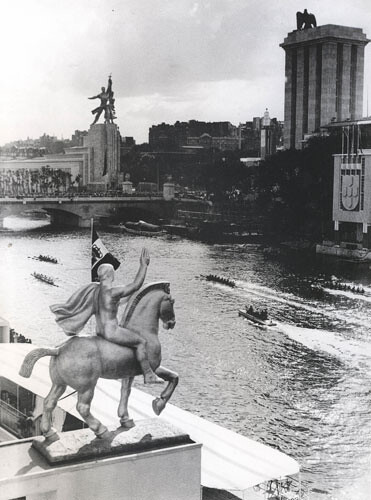

1. The World Fair
Artworks on display at the Venice Biennale historically follow the logic of the world fair, a model established in 1851 with the building of the infamous Crystal Palace in London’s Hyde Park. Cultural anthropologist and philosopher Raymond Corbey states that
from 1851 onward, when the first international exposition took place in London, an enormous variety of industrial and technological products were exhibited, including steam machines, lawnmowers, elevators, photographic cameras, mechanized weaving looms, and household appliances … Various architectural styles were presented, and after 1885 the arts became a recurrent theme. The idea was to show progress in all fields—not only in industry, trade, and transportation, but also in the arts, the sciences, and culture. Meanwhile, there was no mention of poverty, sickness and oppression, or social and international conflicts.3
The infrastructure of the modern world fair embodied the ideal of peaceful, international coexistence among nation-states. Each of the national buildings functioned as a cultural embassy, comparable to “gigantic potlatches, joyous ritual displays of richness and power, where possessions were given away and even destroyed in great numbers in order to gain prestige and to outdo others.”4 These peaceful and sanitized displays sought to prove that the participating nations were capable of engineering civilization. Western nations established their “democratic” capacity by acknowledging a variety of different cultures in their displays—and then demonstrating that they could manage these cultures. The first world fair included 17,000 exhibitors, of which 7000 alone came from the United Kingdom and its colonies.5 From the 1878 edition in France onward, these even included the live exhibition of “natives” in settings mimicking their “original” way of life. In the words of historian Lisa Munro,
The fairs allowed fairgoers a didactic experience that relied on the consumption of images and tangible objects that broadcast the world views of elite classes. The confluence of multiple and intertwined concepts, such as nationalism, colonialism, and industrialization, represented important themes that influenced citizens in their daily lives … Expositions were aimed to categorize and classify the entire world and present visitors with an encapsulated, cohesive vision that explained fundamental questions about the role of human beings in the world through extraordinary means.6
The organization of industrial and cultural objects by region in the first world fair would later translate to the model of national pavilions: temporary buildings, attributed to a specific country, functioning as exhibition centers. In the Venice Biennale, this model would be applied from 1907 onward. The first countries to host the world fair—the United Kingdom (1851), the United States (1853), and France (1855)—occupied powerful positions comparable to those of the first countries to secure a permanent national pavilion on the grounds of Venice’s Giardini: the colonial powers of Belgium, Germany, and the United Kingdom (all in 1907).
The world fair modeled the principle of capitalist democracy before it became an established form of governance. The term “capitalist democracy” emphasizes democracy not as a neutral framework capable of embracing a variety of different ideologies, but as an ideology in and of itself. Lenin also referred to this ideology as “democratism”:
Besides the interests of a broad section of the landlords, Russian bourgeois democratism reflects the interests of the mass of tradesmen and manufacturers, chiefly medium and small, as well as (and this is particularly important) those of the mass of proprietors and petty proprietors among the peasantry.7
The world fair model highlights three crucial characteristics of democratism: (1) the desire to engineer peaceful coexistence among different cultures and ideologies; (2) a prohibition against questioning the engineering structure—colonial capitalism—upon which this peaceful coexistence is based; and (3) the close collaboration between government and private enterprise. In Lenin’s time, this private enterprise consisted of “the mass of tradesmen and manufacturers.” In our time, it is corporations. Alain Badiou refers to the engineering structure of democratism as the “capitalo-parliamentarian order,”8 but we will hold on to the term “capitalist democracy,” since it addresses both the engineering structure and its formal, self-justifying appearance.
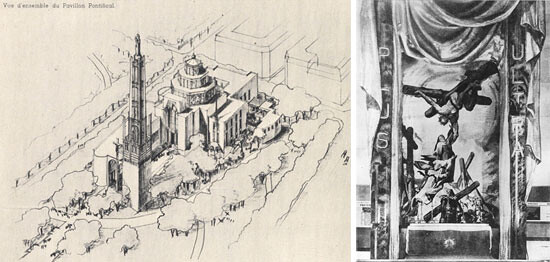

2. Propaganda
It is hardly surprising that Dubai won the bid to host the World Expo 2020. Dubai embodies the world fair precisely as it was originally conceived: as a democratic event without parliamentary democracy. At first glance, Dubai seems to exemplify the ideal of a multicultural society. It has achieved peaceful coexistence between Emirati citizens, who are the minority in the state, and immigrant workers from countries like Pakistan, India, the Philippines, who are the majority. However, Dubai—which is really a corporation in the form of a state led by the Maktoum family—can only exemplify this ideal as long as the ruling structure underlying it remains uncontested.
The radical libertarian model of Dubai has developed into an global hub that embraces both Israeli businessmen (who are eligible for dual citizenship, despite the Arab League’s official boycott of Israel) and international drug trafficking.9 Dubai achieved a major diplomatic victory when US vice president Dick Cheney asked the emirate to oppose Iran’s nuclear program, on the same day that Iranian president Mahmoud Ahmadinejad asked the emirate to support it. In a performative diplomatic preparation for the World Expo, Dubai said yes to both, ensuring that trade contracts would continue to be signed with both countries.10 The Maktoum family has dreamed the dream of democratism: to host a world fair that will uphold, through culture and industry, the formal appearance of democracy, without having to actually go through the trouble of elections.
While democratism is ubiquitous today, the Paris world fair of May 1937 posed a considerable challenge to the sustainability of this form of governance. With Europe on the brink of another world war, the central intention of the 1937 world fair was, according to art historian Dawn Ades, to “shore up Europe’s faith in civilization (the question of whose civilization could not be looked at too closely) … Only in a world fair on this scale would it have been possible for the Spanish Republicans and Nationalists to be present simultaneously.”11 While we remember the Republican pavilion, since it was the first place where Picasso’s Guernica was publically displayed, there is little understanding of how a pavilion for the Spanish Nationalists, who were not yet in power, ended up in the world fair. How did Franco’s military insurgency against a democratically elected government gain a place alongside established nations?
The answer: the Vatican. It was thanks to “the Nationalists’ fusion of politics and religion … that the Vatican provided Franco’s side with an opportunity to participate.”12 What makes this intervention so relevant is not simply the perverse bond between the religious institution of the Vatican and military fascist regimes, but the fact that it lays bare the very origin of the concept of propaganda:
The original use of the word to describe the propagation of beliefs, values, or practices has been traced to the seventeenth century, when Pope Gregory XV named in 1622 the Congregatio de Propaganda Fide (Congregation for the Propagation of the Faith), a missionary organization set up by the Vatican to counteract the rival ideas of the Protestant reformation.13
Franco’s creation of a pavilion within the Vatican’s pavilion—even before the city-state itself existed—reveals what is at stake in the so-called peaceful coexistence of nation-states at the world fair: a battle for acknowledgement by the key players of democratism. What Franco understood was that in the context of the world fair, an excessive display of power would undermine his cause. Rather, he simply had to become one among many respected states. His cause was aided by two nations that did not share his concern for subtly and restraint at the fair.
If the decision to place the German and Soviet pavilions in the centrally located International Exhibition, next to the Seine, was an attempt to enforce the idea of European unity, the effort failed. The Soviet pavilion, designed by architect Boris Iofan, functioned mainly as a pedestal for Vera Mukhina’s enormous sculpture Worker and Collective Farm Woman, depicting two gigantic figures striding forward while holding a hammer (male) and a sickle (female). If these figures were striving toward anything, it was toward the German pavilion, which was directly in front of the Soviet pavilion, across a road. In his autobiography, architect Albert Speer, who designed the German pavilion, writes that he accidentally came across drawings of the Soviet pavilion and decided to anticipate the design.14
His principle aim was to “create an imperial, quasi-religious monument that would counter the forward thrust of the Soviet pavilion and dominate it in height. In opposition to Boris Iofan’s dynamic, multiplanar structure, the fortress-like façade of the Deutsches House appeared stoic and immutable.”15 The monumental male nudes in Josef Thorak’s sculpture Comrades were placed in front of Speer’s construction, while an eagle positioned on top guarded the surrounding area. Both constructions—each challenging the other, forcing an even more aggressive and monumental aesthetic—were as much military statements as artistic statements, with Speer at the frontline, anticipating the cultural move of the enemy.
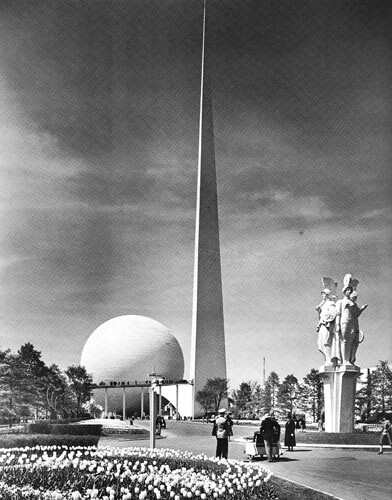

The role of art as propaganda in capitalist democracy is such a taboo subject precisely because the monumental structures of the 1937 German and Soviet pavilions so violently portrayed what we would come to understand as propaganda. However, it was in their shadow that Franco was able to provide his fascist rule with a sense of cultural respectability. The Soviet and Nazi totalitarian imagery takes all other images hostage because of its unrestricted identification with ruling powers—and this is just what Franco anticipated. This dynamic reveals how liberal democracy has been historically dependent on “totalitarianism.” As Slavoj Žižek writes:
Throughout its entire career, “totalitarianism” was an ideological notion that sustained the complex operation of … guaranteeing the liberal-democratic hegemony, dismissing the Leftist critique of liberal democracy as the obverse, the “twin,” of the Rightist Fascist dictatorship … Far from being an effective theoretical concept, [totalitarianism] is a kind of stopgap: instead of enabling us to think, forcing us to acquire new insight into the historical reality it describes, it relieves us of the duty to think, or even actively prevents us from thinking.16
In other words, the seeming aesthetic clarity of the notion of “totalitarian art,” as Igor Golomstock calls it, obfuscates similar mechanisms of propaganda that uphold the democratist doctrine. From the perspective of institutional critique, the German and Soviet pavilions provided an ultimate critique of the obscured dimension of power in the world fair. The violence of cultural imperialism that gave birth to the concept of the world fair as democratism avant la lettre is made invisible through its seeming interest in cultural exchange and civilized progress. But this exchange can only take place through a monopolization of power that allows everything to be questioned—except for the power structure underlying the world fair itself. It is important to emphasize that the excess of power manifested through the German and Soviet pavilions was shocking not simply due to its pompous and obscene violence, but because the other state pavilions refused to manifest themselves in equally explicit visual terms.
This take on institutional critique has obviously not been shared by many, and the consequence has been that our conception of propagandistic art has been restricted to so-called totalitarian regimes, including Fascist Italy and Maoist China. Only when hysterical musicals and posters slip through the North Korean border is the word “propaganda” used in a more or less serious manner, yet always with the full conviction that only the most brainwashed of people could be susceptible to the manipulative force of this kind of imagery. This is what I refer to as “propaganda’s propaganda”: the absolute conviction of inhabitants of democratism that their world is lucid, whereas the poor, underdeveloped subjects of Kim Jong-un still naively gather in celebration around images of happy factory workers and peasants. Apart from this being a grave misunderstanding of those subjected to this type of imagery, it is exactly this logic that structures democratist propaganda par excellence: the belief that we are somehow “beyond” propaganda. The idea that there is a clear and absolute historical distinction between totalitarianism and democracy is the core of propaganda’s propaganda.17
The Soviet and German pavilions challenged the success of the democratist doctrine both visually and militarily, but through their violent and explicit imagery they also provided the basis for the widespread belief in this distinction.
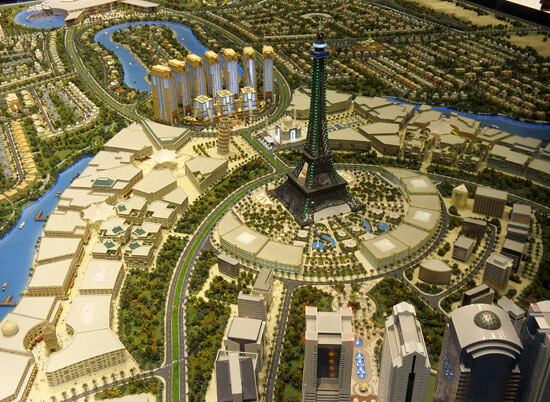

3. Invisible Government
Contrary to what many believe, propaganda was not invented by the Nazis or the Soviets. In fact, Hitler and his propaganda minister Joseph Goebbels based the Third Reich’s propaganda apparatus on Hitler’s own experience in the army during the First World War. Hitler was convinced that the defeat of Germany had been the result of the refined propaganda tactics of the British War Propaganda Bureau, which operated from 1914 to 1917. This bureau, generally referred to as “Wellington House,” in no way fits the prevailing image we have of propaganda. It did not make agitprop posters, it did not commission gigantic bronze statues, and it did not primarily target the masses. Instead, Wellington House developed an intricate network focused on gathering and distributing knowledge to elites in the societies that the British needed on their side. Its main tactic was to never have its actions be recognized as propaganda. It achieved this by giving all the information it distributed an air of academic precision and impartiality. As Phillip Taylor, a scholar of communication, writes:
Educated people like to believe that they can spot propaganda when they see it. And, having duly identified it as such, they can readily dismiss it as “propaganda.” Wellington House therefore had to disseminate material to its target audience that did not appear to be propaganda but rather took the form of reasoned, almost quasi-academic, explanations of the issues involved, with the facts—even not all the facts—presented in an objective manner and with measured argument.18
In the nineteenth century, the British had built a global cable communications system. Known as the “All Red Network,” it was comprised of underwater cables that connected the vast British Empire to the rest of the world. The first act of warfare that the British engaged in against the Germans, even before a single shot was fired, consisted of
the cutting, within hours of the ultimatum to Germany expiring, of the direct transatlantic cables from Germany to the United States by the Telconia [an English cable ship] … It meant that thereafter all German news, information and opinions about the war, its cause and course, had to reach the USA by indirect routes through cable relay stations in neutral countries in Scandinavia and Iberia … which the British … were intercepting.19
In the three years it existed, Wellington House used its budget of two million pounds to produce newspapers, photographs, documentary films, millions of pamphlets (some of which were dropped from balloons and airplanes behind enemy lines to convince soldiers to desert), and even “academic” studies written by hired historians. Prominent novelists such as H. G. Wells joined its ranks and wrote pamphlets and essays. But the core of much of this discursive and visual material lay in what it was not representing. The greatest achievement of Wellington House was to perfect censorship in its rawest form: the monopoly on the distribution of information.
Modern propaganda was thus born in Britain, a supposed paragon of democracy. The aim of this propaganda was to sustain the belief among British citizens that information circulated freely and that public opinion was formed without coercion. But at the same time, this propaganda regulated the performative experience of these very same democratic citizens. Democratist propaganda is thus performed, its values internalized, in the most profound belief that its subjects are “outside” propaganda. This undermines the popular conception of propaganda, revealing that democratist propaganda actually preceded that of the Nazi’s and the Soviet’s.
The overly explicit struggle for power by the German and Soviet pavilions threatened the delicate balance the world fair had achieved between, on the one hand, a visible exchange among cultures, and on the other, the invisible use of the world fair as a means of establishing the doctrine of democratism. Only two years later, Edward Bernays, the nephew of Sigmund Freud (who would go on to popularize his uncle’s ideas) was employed by the American president Woodrow Wilson in his own Wellington House—the Committee on Public Information. Bernays restored this delicate balance when he became publicity director for the New York world fair of 1939. In his book Propaganda (1928), Bernays had already considered a different term for the concept of propaganda; due to the negative connotations the word had obtained after WWI, he proposed to refer to propaganda as the “public relations industry.”20
Through this concept of public relations, Bernays brilliantly connected the dangers that representative politics posed to democratism, and the risk involved in the blatant exhibition of power by the Nazis and the Soviets at the Paris world fair. By working from the glorious example of Wellington House, Bernays left the concept of propaganda to the “totalitarian” states in order to enforce the sense of an absolute distinction between dictatorship and to the free world. Instead of the overt authoritarianism of dictators, he proposes the idea of an “invisible government”:
The conscious and intelligent manipulation of the organized habits and opinions of the masses is an important element in democratic society. Those who manipulate this unseen mechanism of society constitute an invisible government which is the true ruling power of our country. … This is a logical result of the way in which our democratic society is organized. Vast numbers of human beings must cooperate in this manner if they are to live together as a smoothly functioning society.21
What Bernays took from Wellington House was the idea of a far-reaching, invisible infrastructure that could govern society. But instead of seeing this type of “secret governance” as something limited to a state of emergency (as was the original idea of Wellington House), Bernays declared a state of total propaganda in both war and peacetime. Moreover, he believed that the problem of total war, as a product of modern technological society, could only be solved by propaganda. This notion is reflected in the work of philosopher Jacques Ellul, who called the propaganda of the public relations industry a “sociological phenomenon” necessary for managing the alienated “lonely crowd” (which Bernays calls the “bewildered herd”) of postindustrial society.22
Indeed, Bernays considered propaganda the one and only “democratic” way to deal with the unpredictable, anxious masses. The “death drive” of the “bewildered herd” had to be engineered. This was the public relations industry’s primary task: to “manufacture consent,” to understand what the masses wanted even before they knew it themselves.
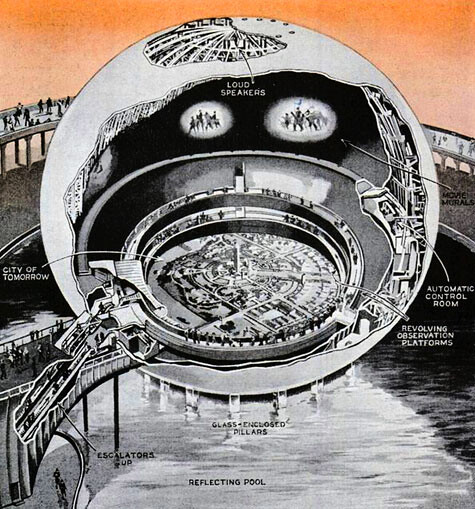

4. Democracities
Bernays’s vision formed the centerpiece of the New York world fair. Entitled “The World of Tomorrow,” the fair featured national as well as corporate pavilions. That is, it celebrated the prospect of a new corporate politics to come. At the heart of the fair was a massive structure called the Trylon and Perisphere, which at the time was one of the tallest buildings in New York (after the Empire State Building). Visitors entered the construction through an electric staircase, and once inside they encountered a gigantic rotating architectural model of the city of the future: Democracity, designed by Henry Dreyfuss and crafted in accordance with Bernays’s notion of invisible government. The model embodied a utopian urban structure made possible through the replacement of representative government by the corporate rule of the public relations industry. It neatly separated the different needs of its inhabitants into zones, consisting of Centerton (the social and cultural center), the Pleasantvilles (middle class residential towns), Milvilles (industrial towns), and Farms, with proximity to Democracity’s city center determined by class position (the Pleasantvilles being the most luxurious and thus the nearest to Centerton). In Democracity’s brochure, writer and cultural critic Gilbert Seldes adopted the tone of real estate promotional materials when he wrote:
If Democracity were Utopia, government would be superfluous. But Democracity is an entirely practical city … And there can be a dozen or a hundred such groups of towns and villages and centers in the United States, each with commercial and agricultural and industrial interests. The government exists to see that these interests harmonize … The City of Tomorrow which lies below you is as harmonious as the stars in their courses overhead—No anarchy—destroying the freedom of others—can exist here. The streets, the houses, the public buildings, the waterways, the parks, and the parking spaces—all are built in relation to all the others.23
The resemblances between Democracity and what James Holston calls the “CIAM doctrine” are striking.24 This doctrine outlines the ideal of the modernist city as elaborated by the Congrès Internationaux d’Architecture Moderne (CIAM), an organization founded by architect Charles-Édouard Jeanneret, better known as Le Corbusier. The central premise of the CIAM doctrine is indeed the zoning of the city into different typologies of social activity—such as housing, work, recreation, and traffic. But whereas CIAM planned these social units on an anticapitalist and egalitarian basis, Bernays believed that it was through capitalism—which he considered inherently democratic—that we would arrive at a society of “independent and therefore interdependent men.”25 Whereas CIAM upheld the notion that people could be liberated though state industrialization, thus reducing politics to the administration of an egalitarian social order, Bernays believed that only through engineering—and the creation of corporate conglomerates—could people be liberated from their incapacity to govern themselves.
What Bernays described was basically the replacement of the state by corporations—corporations being natural democratic entities insofar as they can represent the desires of the people in a way that governments cannot. This is crucial in order to understand the governance of the modern democracity. For in actuality, it is not a city, but rather a corporation in the form of a city. This links the 1939 world fair to World Expo 2020 in Dubai: a city engineered by an invisible government of family-owned corporations and public relations industries, which intervenes in the lives of its people only when the construction of skyscrapers and artificial palm-shaped beaches is threatened by strikes or other forms of political organizing (in these cases, the authorities intervene violently). In the democracity that is Dubai—perfectly in line with Bernays—much is tolerated, except for organized political agitation. Consequently, politics in Dubai consists only of diplomacy among invisible governments. What is left to the people is culture. Bernays predicted the future of democratism, with the world fair as its prototype.
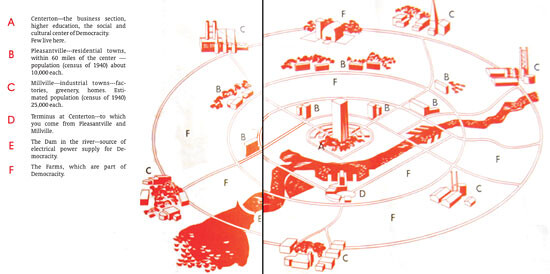

How does the democracity of Dubai relate to the Venice Biennale? I propose that we regard the Biennale’s infrastructure as an alternative world map. From this perspective, curators and artists become ambassadors in the field of global power politics. In the context of the Venice Biennale, art does not imagine the world “differently,” but rather more accurately. Walking from the Israeli pavilion to the US pavilion (not incidentally, placed right next to each other), or from the Giardini to one of the many “collateral programs”—pavilions of stateless states such as Palestine, Catalonia, and Wales—has nothing to do with visiting exhibitions. It has everything to do with enforcing this alternative world map.


As visitors we perform ideology by becoming occupied in our very being by its construct. By moving through Venice’s alleys and gardens, from one pavilion to the next, we enact the underlying geopolitical ties that structure the alternative world map. Through our very presence, the base (the network of geopolitical alliances represented by the pavilions) and the superstructure (the artworks on display) become harder and harder to distinguish from one another. We are the subjects through which democratist ideology is performed. But in contrast to the modern democracity’s smooth, invisible government, the geopolitical chess board of Venice, where the struggle over Europe’s retreating cultural hegemony is played out, manifests itself as a space of permanent collapse. We see this plainly in the rise of the BRIC countries, and in the global democratization movements such as the Indignados, Occupy, and the Gezi Park protests (which also defend a notion of democracy without parliamentary representation, but with very different goals). The newly politicized inheritors of institutional critique are slowly forcing Venice’s hidden infrastructure—and our performative role within in—to the surface. Like the German and Soviet pavilions in Paris, the infrastructural body of Venice undeniably breathes power, to the point that the performance of each visitor must inevitably be recognized as a political act. It is in the Venice Biennale—a world map that allows us to trace the development of geopolitics since 1895—that we might slowly learn to speak three words that have been separated for too long:
Art.
Democracy.
Propaganda.
And recognize that all this time, they have formed an inextricable whole.
Hito Steyerl, The Wretched of the Screen (Berlin: e-flux journal and Sternberg Press, 2012), 93.
Vittoria Martini, “A brief history of I Giardini: Or a brief history of the Venice Biennale seen from the Giardini,” in Muntadas/On Translation: I Giardini, Spanish Pavilion (Actar, Barcelona 2005). This quote comes from an updated version published on the Art and Education publication platform. See →
Ibid.
Ibid.
Lisa Munro, “Investigating World’s Fairs: An Historiography,” Studies in Latin American Popular Culture, vol. 28 (2010): 91.
Lisa Munro, “Investigating World’s Fairs: An Historiography,” Studies in Latin American Popular Culture, vol. 28 (2010): 91.
Vladimir Lenin, “Working-Class and Bourgeois Democracy,” in Lenin Collected Works, vol. 8 (Moscow: Foreign Languages Publishing House, 1962), 72–82.
Alain Badiou, The Rebirth of History, trans. Gregory Elliott (New York: Verso, 2012), 40.
Jim Krane, Dubai: The Story of the World’s Fastest City (London: Atlantic Books, 2009), 74, 105, 168–9
Ibid., 283–5
Dawn Ades, “Paris 1937—Art and the Power of Nations,” in Art and Power, ed. David Britt (London: Hayward Gallery, 1995), 58.
Ibid., 64.
Toby Clark, Art and Propaganda in the Twentieth Century (New York: Abrams Books, 1997), 7.
Igor Golomstock, Totalitarian Art (New York: Overlook Duckworth, 2011), 133–34.
Karen A. Fiss, “The German Pavilion,” in Art and Power, 108.
Slavoj Žižek, Did Someone Say Totalitarianism? (London: Verso, 2001), 3.
It is worthwhile to look at documentaries such as the Discovery Channel’s Children of the Secret State (2001) and National Geographic’s Inside North Korea (2006), in which the interviewers bluntly put their obviously state-monitored guides in danger by asking whether there is anything “bad” about their leader—after which of course the guides express even more excessive praise of him. The guides know that having even provoked such a question from an interviewer could result in death. Despite the obvious discomfort of the guides, the interviewers continue to refer to the posters of the late Kim Jong-il they encounter as “eerie propaganda.”
Philip M. Taylor, British Propaganda in the Twentieth Century: Selling Democracy (Edinburgh: Edinburgh University Press, 1999), 36.
Ibid., 45.
See also Adam Curtis’s well-known documentary series Century of the Self (2002), an introduction to the transformation of the concept of propaganda through the application of mass psychoanalysis by the public relations industry.
Edward Bernays, Propaganda (New York: Ig publishing, 2005), 37.
Jacques Ellul, Propaganda: The Formation of Men’s Attitudes (New York: Vintage Books, 1967).
Gilbert Seldes, Your World of Tomorrow (New York: Rogers-Kellogg-Stillson, Inc., 1939), 15, 13.
James Holston, The Modernist City: An Anthropological Critique of Brasília (Chicago: University of Chicago Press, 1989), 41.
Gilbert Seldes, Your World of Tomorrow (New York: Rogers-Kellogg-Stillson, Inc, 1939), 15.
Category
Subject
This essay was developed around the Ideological Guide to the Venice Biennale, a project by Jonas Staal in the form of a free iPhone and Android app providing insight into the political, economic, and ideological infrastructure of the Biennale. The guide offers critical reflections by prominent artists, curators, and theoreticians that help the user explore the ideological framework of each national pavilion. Additional data provides information on the political background, selection procedure, and financing of each of the exhibitions on display. The Ideological Guide to the Venice Biennale is supported by: Kadist Art Foundation, Paris; Center for Visual Art, Rotterdam; Farook Foundation, Dubai; PhDArts, Leiden; and Promoveren in de Kunsten, Amsterdam. The travel grant is a co-initiative of Casco, e-flux, and Kadist Art Foundation.
